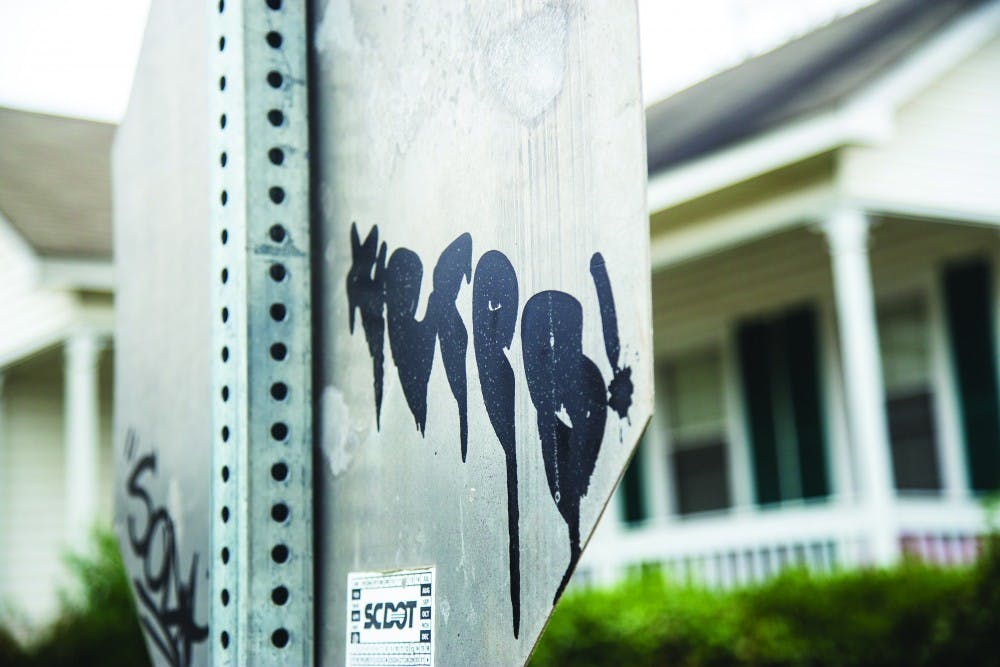It doesn’t take very long living in Columbia to realize trains are a big part of everyday life. They can make getting to class difficult, create a killer traffic jam and be an overall general annoyance. Yet, the echoes of their horns are enmeshed with the sound of the city – the sound that lets you know a free art exhibit is about to drive by. Graffiti art can be found scaling the walls of nearly every train car, from artists that stretch across the country to our own city of Columbia.
One of those artists is Terps, a garnet-and-black-blooded vandal you probably know without knowing. Or rather, you know his art: the legendary painted Terps face that can be found both on and off campus by students and citizens alike.
That same painted face could also land Terps in jail, making it so I was only able to find him after a year of searching, when I eventually ran into his Instagram account, @terrps.
As he sat on my couch to discuss his art, the potential threat to his security as a hidden artist due to my presence was tangible, but he reassured me getting his voice out there for the graffiti community was well worth it.
Like many artists, Terps had simple beginnings. Some of his earliest memories in childhood are of doodling, daydreaming, and being in his favorite class – art. It was from those very art classes that the Terps we know today was born, sticking to his humble roots in the years since.
“In the seventh grade we were doing portraits and my art teacher drew a really basic face, and I’ve both simplified it some and [made it] a little more complex. That’s where the face came from,” said Terps.
He pointed out that originally, his tag – which is the specific marking unique to that particular artist – was merely the face. It’s a distinct face, with large “C”s as eyes framed by squiggly eyebrows, the type that was a relatively disturbing Instagram fad in early 2018. The nose is long and sloped toward the bottom, where there is the meeting of cupid’s bow and large lips in a seeming smirk.
Only later did he add the name Terps to the face for branding purposes. Still, he feels as though he will always be “The Face Guy” to many people, especially since his original work sans labeled Terps is still marked across the country.
Terps explained, “These trains that come through Columbia, they sometimes end up across the country. I’ve heard of my tags ending up in places like Texas, California, and Oregon. Trains bring a lot of art in.”
It was the trains in Beaufort that first caught the eye of Terps, who suddenly noticed an artist, Butta, whose tag was plastered all over the town. He noted that while the average person can certainly appreciate graffiti, becoming more familiar with an artist can give said graffiti more context.
“I’d noticed Avoid and Sour [in Columbia], but Butta made me look at graffiti differently. There’s a difference between just watching a train go by and actually looking and watching all these peoples’ art go past and noticing that you’ve seen that same tag elsewhere. You can put two and two together. It’s fun and like playing a game for who you can see when and where,” said Terps when discussing his greatest influences in the graffiti scene.
Both Avoid and Sour’s work can be seen around the Columbia area, often beside that of Terps, as is the case from most graffiti artists that have tagged in the same area during various periods of time. Terps explained that as artists move, so does their art. While it’s unclear when artists such as Avoid and Sour tagged in the Columbia area, the interaction between artists through art instead of face-to-face raises some questions. What does it mean to be part of an illegal community of artists? Is there friendship or rivalry?
“It’s just a bunch of grown men writing on things. Sometimes people get territorial, but there’s a general respect among graffiti artists. You learn as you do it more. I made some mistakes when I first started tagging and I’ve learned from that,” stated Terps.
Respect seems crucial in an art form like graffiti, where artists like Terps tag on a daily basis, with the longest Terps having ever gone without tagging being no longer than a week. When your art is a part of a constant process, finding spaces that don’t interfere with others’ work is vital. Tags are the equivalent of writing “(Blank) was here” thousands of times on various items or buildings for years, inadvertently creating an artist showcase for those willing to venture out and look.
Needing to search to see the work of a particular artist may sound strange, but is essential for a great deal of graffiti art due to the practice itself being illegal. While it can be easy to associate graffiti with artists such as Banksy and Shepard Fairey, it’s important to understand that such artists are actually street artists, not graffiti artists. Street artists use legal walls and generally make a profit. Graffiti artists are artists without a face, or rather, artists that have no choice but to be an artist without a face due to the places where they place their art being illegal, with no profit to be earned. This fact makes graffiti a controversial art form with both the public and traditional artists.
“I’m not going to deny it [is vandalism], but I’m not writing on churches or businesses. I’m just trying to get my art out there, not be disrespectful. Signs, stuff kicked to the curb, trashcans, stuff I know will be power washed; that’s where I tend to go,” said Terps.
Regardless of public opinion, Terps is adamant that he will continue tagging regardless of where life takes him – and he’s not the only one. If you don’t believe it, just wait for the next train.



